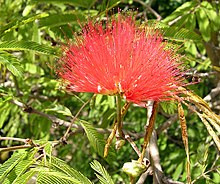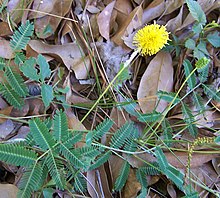Mimosoideae
Mimosoideae is a subfamily of plants belonging to the legume family (Fabaceae). Its name comes from the type genus, Mimosa.
Well-known species belong to the mimosóideas, such as the true acacias, the mimosas or sensitive, the ingáes, timbóes and plumerillos, the aromos, tuscas, garabatos, espinillos and algarrobos. They abound among the large trees of tropical forests, dominate many savannahs, and are always common in hot semi-desert regions, as Acacia anastema. Many mimosoids are grown as shade trees, ornamentals, shelter plants, or for forestry purposes.
They preferentially inhabit warm regions, and are very well represented in the tropical regions of Africa and America where there are often gigantic species. They comprise 82 genera and about 3,300 species. The genera with the largest number of species are Acacia sensu stricto (960, including only the species previously included in the subgenus Phyllodinae), Mimosa (480), Inga (350), Calliandra (200), Vachellia (161, previously known as Acacia subgenus Acacia), Senegalia (85, previously included within Acacia subgenus Aculeiferum), Prosopis (45), Pithecellobium (40).
Description
They are trees or shrubs, rarely herbs, with graceful foliage due to their bipinnate leaves, rarely pinnate or reduced to phyllodes. In many cases they are thorny and have a very particular appearance due to the small flowers added in heads or spikes which, in turn, usually form dense spiciform clusters or large panicles.
The flowers are actinomorphic. The corolla has valvar pre-flowering, often with tubular and welded petals. The calyx is valvar or, in some groups, imbricated, with the sepals always welded together. The androecium is formed by 4, 8, 10 or numerous stamens, which exceed the height of the corolla. The staminal filaments are free or welded together. Pollen is generally compound. The ovule is anatropous. The seed presents a straight embryo and the integument presents a "fissure line" (pleurogram in botanical English —from pleuro, side, lateral, and gramma, line, that is, 'lateral line') shaped like a ring or horseshoe. The thread is apical or subapical, small.
Taxonomy
This subfamily is divided into five tribes: Acacieae, Ingeae, Mimoseae, Mimozygantheae, and Parkieae.
Acaciae
This tribe is represented by the genera Acacia and Faidherbia. They present flowers with a large number of stamens (always more than 10) with free filaments. The leaves in the members of this tribe are bipinnate or are replaced by phyllodes. In some species of Acacia, both phyllodes and bipinnate leaves coexist, especially in young individuals. They may be unarmed or have spiny stipules.
Ingeae
- Abarema
- Albizia
- Archidendron
- Archidendropsis
- Balizia
- Blanchetiodendron
- Calliandra
- Cedrelinga
- Cojoba
- Ebenopsis
- Enterolobium
- Falcataria
- Guinetia
- Havardia
- Hesperalbizia
- Hydrochorea
- Inga
- Leucochloron
- Lysiloma
- Marmaroxylon
- Painteria
- Pararchidendron
- Paraserianthes
- Pithecellobium
- Pseudosamanea
- Serianthes
- Sphinga
- Wallaceodendron
- Zapoteca
- Zygia
Mimoseae
- Adenanthera
- Adenopodia
- Alantsilodendron
- Amblygonocarpus
- Anadenanthera
- Aubrevillea
- Calliandropsis
- Calpocalyx
- Cylicodiscus
- Desmanthus
- Dichrostachys
- Elephantorrhiza
- Copy that.
- Fillaeopsis
- Gagnebina
- Indopiptadenia
- Kanaloa
- Lemurodendron
- Leucaena
- Microlobius
- Mimosa
- Neptunia
- Newtonia (planta)
- Parapiptadenia
- Piptadenia
- Piptadeniastrum
- Piptadeniopsis
- Plathymenia
- Prosopidastrum
- Prosopis
- Pseudopiptadenia
- Pseudoprosopis
- Schleinitzia
- Stryphnodendron
- Tetrapleura
- Xerocladia
- Xylia
Mimozygantheae
- Mimozyganthus
Parkieae
- Parkia
- Pentaclethra
Contenido relacionado
Frankeniaceae
Dichanthium
Calderonella sylvatica




